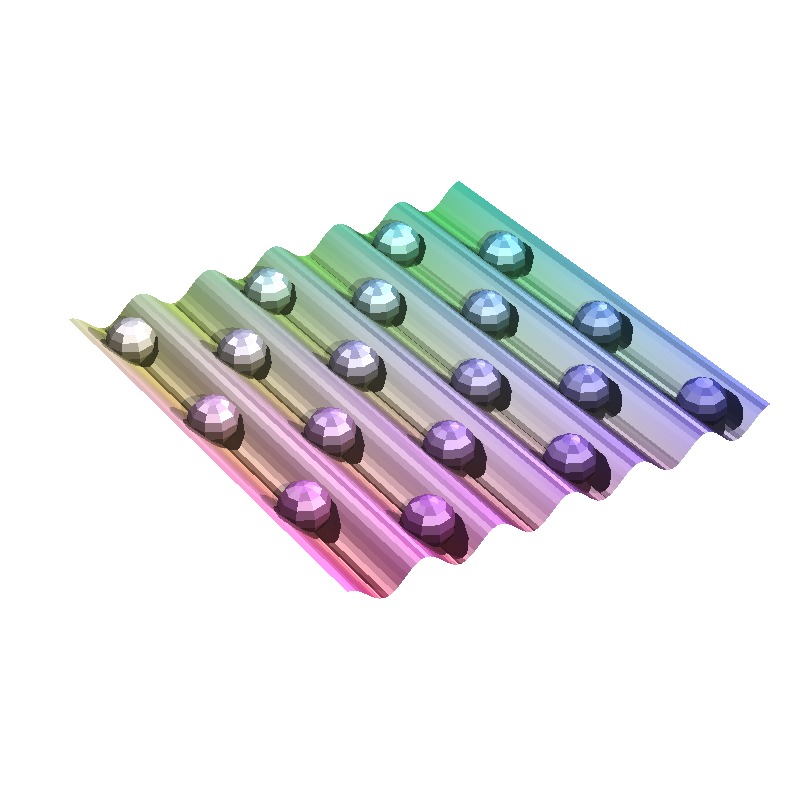
Minimisation trends in physics and technology have caused a lot of interest in monolayers and their interactions with a substrate lately. Colloidal suspensions have proven to be ideal model systems for studies on such systems. Ordering phenomena in such systems can be successfully studied by model systems as binary hard-disk mixtures, the influence of a substrate being modelled by an external potential. Monodisperse two-dimensional colloidal systems in interaction with a substrate potential have been studied extensively in experiments [d1,d4], computer simulations [b1-6,d3,d7] and theory [d2,d5-6] over the last decades. Reentrant phase transition scenarios like Laser Induced Freezing (LIF) and Laser Induced Melting (LIM) have been observed. The details of the phase diagram depend e.g. on the commensurability of the external potential with the periodicity of the monodisperse triangular lattice. We analyse the resulting changes in the phase behaviour for monodisperse hard disks for a variety of commensurability ratios p [b5,c5].
Another focus of our research is on ordering phenomena in binary mixtures in external fields. Here we address the question of how the addition of another length scale into such a system influences the intricate competition between adsorbate-adsorbate and adsorbate-substrate interaction by studying a binary equimolar mixture under the influence of a one-dimensional spatially periodic substrate potential. The wavelength of the external potential is chosen to be commensurate to the periodicity of the S1(AB) lattice.
For the field-free case the thermodynamic stability of space-filling lattice structures for binary hard-disk mixtures was studied by Monte Carlo computer simulations. As these structures prove to be thermodynamically stable only in high pressure environments, the phase behaviour of an equimolar binary mixture with a diameter ratio of 0.414 exposed to an external, one-dimensional, periodic potential is analysed in detail. In general one can distinguish three cases: I) only the smaller component interacts with the external field, II) both components interact with the external field and III) only the larger component interacts with the external field. The underlying ordering mechanisms and the resulting order differ considerably, depending on which components of the mixture interact with the external potential. The simulations show, that slight deviations in the concentration of large particles or the diameter ratio have no impact on the occurrence of the various field-induced phenomena as long as the mixture stays in the relevant regime of the packing fraction.
b) Old publications
- W. Strepp, S. Sengupta, and P. Nielaba, Phys. Rev. E63, 046106 (2001).
- W. Strepp, S. Sengupta, and P. Nielaba, Phys. Rev. E66,056109 (2002).
- W. Strepp, S. Sengupta, M. Lohrer, P. Nielaba, Comp. Phys. Commun. 147, 370 (2002); Mathematics and Computers in Simulation 62, 519 (2003).
- K. Franzrahe et. al. Comp. Phys. Commun. 169, 197 (2005).
- F. Bürzle, P. Nielaba, Phys. Rev. E76, 051112 (2007).
- P. Nielaba, W. Strepp, Phase transitions and quantum effects in model colloids and nanostructures, in: Path Integrals - New Trends and Perspectives, edited by W. Janke and A. Pelster, World Scientific, Singapore, pp. 321 (2008).
c) Completed work
- W. Strepp, diploma thesis: Monte-Carlo-Simulation von harten Scheiben in einem äußeren periodischen Potential (1999)
- W. Strepp, dissertation: Theoretische Untersuchungen zu Phasenumwandlungen in Modell-Kolloiden in äußeren Potentialen und eingeschränkter Geometrie (2003)
- F. Bürzle, diploma thesis: Numerische Studien zu Phasenumwandlungen zweidimensionaler Modellkolloide in periodischen Potentialen (2006)
- K. Franzrahe, dissertation: Theoretische Untersuchungen komplexer Modell-Kolloide: Computer-Simulationen struktureller und elastischer Eigenschaften (2008)
- T. Brokamp, diploma thesis: Auswirkung des Kommensurabilitätsfaktos auf Phasenübergänge zweidimensionaler Modellkolloide in periodischen Feldern (2011)
d) Reference
- A. Chowdhury, B. Ackerson, and N. Clark, Phys. Rev. Lett. 5, 833 (1985).
- J. Chakrabarti, H. R. Krishnamurthy, and A. K. Sood, Phys. Rev. Lett. 73, 2923 (1994).
- J. Chakrabarti, H.R. Krishnamurthy, A. K. Sood, and S. Sengupta, Phys. Rev. Lett. 75 2232 (1995).
- Q.-H. Wei,C. Bechinger, D. Rudhardt, P. Leiderer, Phys. Rev. Lett. 81, 2606 (1998).
- E. Frey, D.R. Nelson, and L. Radzihovsky, Phys. Rev. Lett. 83, 2977 (1999).
- L. Radzihovsky, E. Frey, and D.R. Nelson, Phys. Rev. E 63, 031503 (2001).
- P. Chaudhuri, C. Das, C. Dasgupta, H.R. Krishnamurthy, and A.K. Sood 72, 061404 (2005).
